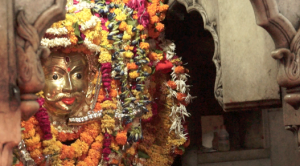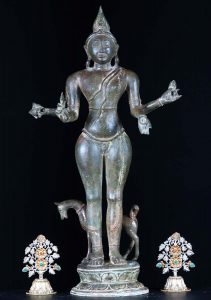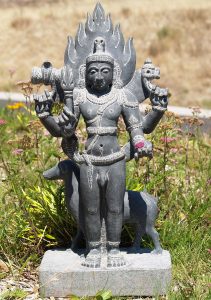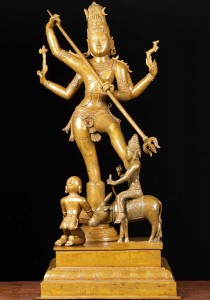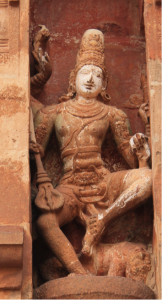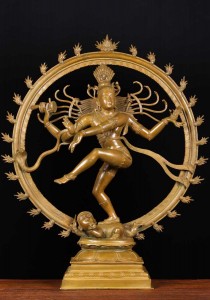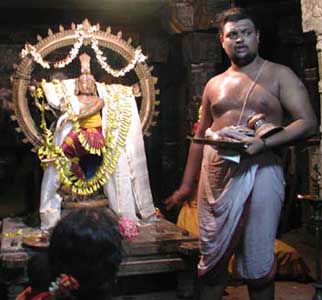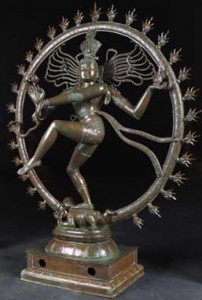The temple town of Madurai is most famous for the Meenakshi – Sundaresvara temple. This temple dates back to the early centuries of the first millennium, but the intricate and magnificent temple complex that exists today was built between 1623 and 1655 CE. The vast temple complex is home to fourteen monumental towers, or gopurams, as well as some 40,000 individual sculptures chronicling scenes from Hindu mythology. Entering through the east gopura, visitors are greeted by the eight forms of the goddess in the Ashta Sakti mandapa. Passing the intricately carved pillars donning the goddess in eight beautiful forms, you arrive at the Muthupillai mandapa named after its donor. This is a wide and dark hall filled with sculptures of Shiva in his various forms. The small rays of light that seep through openings in the granite ceiling make for an enchanting and ethereal experience. Exiting this hall, you are immediately greeted by the bright sunlight and the open courtyard containing the Golden Lotus Pond.

In the middle of this quaint tank, there is a beautiful hundred petal lotus covered in gold. Along the portico, on the way to the main shrine, are beautifully painted murals narrating 64 glorious exploits of Shiva as referenced in the Tamil magnum opus Tiruvilayadal (divine game). The most famous of these is one depicting the celestial marriage of Meenakshi, a form of Parvathi, with the beautiful Siva, or Sundaresvara. The next stop is the Killikoondu mandapa, or the corridor of bird cages. Up until a few decades ago, this hall was filled with hundreds of parrots, considered very dear to the goddess. North of this corridor is the altar of Ganesha. Just beyond this altar resides Goddess Meenakshi in all her regal splendor.
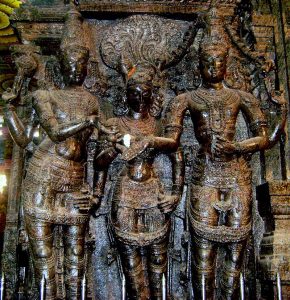
The entire corridor around her sanctum sanctorum is richly decorated with intricate stone carvings and beautiful gold relief work. Inside the Garbha Gruha, literally the womb-house stands the Goddess Meenakshi, carved from a single large emerald stone. Her left-hand hangs gracefully by her side, while her right-hand holds a golden lotus upon which a gold parrot stands. North of her chamber resides her consort Sundaresvara, surrounded by a hall containing gargantuan pillars embellished with carvings of his various forms. The most famous of these is the depiction of the marriage of Meenakshi-Sundaresvara, facilitated by Meenakshi’s brother, Lord Vishnu. Just before exiting the temple, you meet the thousand pillared halls, boasting a beautiful statue of Nataraja and his consort Sivakamasundari, as well as numerous carved pillars depicting the Hindu epics like the Mahabharata.
The famous scene of the sacred marriage is described in the Saiva Karanagama as follows: Lord Shiva shines beautifully like bright saffron. He has three eyes, and four hands. He is adorned with fresh flower garlands and exquisite gold ornaments. His entire body is draped with fine silk garments.
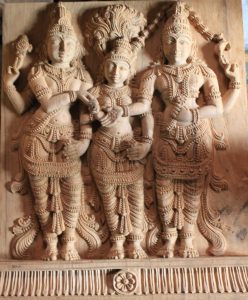
His hands are decorated by jeweled bangles and gold lotuses. He holds the hand of Parvathi with one hand and the ax and deer in his other two. The Lord gleams with the effulgence of a thousand bright suns. He has matted dreadlocks and a diamond-studded crown, embellished by the moon. The Goddess stands next to Shiva, holding his hand. She is decked with the most elegant red silk. Her chest bends slightly due to the weight of her many pearls, gold, ruby, emerald, sapphire, and diamond necklaces. She is adorned with Champa and jasmine flowers in her dark hair. She gleams like dawn. Her brother, Lord Vishnu, pours the holy water on their joined hands to consecrate the divine matrimony. The three stand beautifully under the golden kadamba tree, in the forest of kadamba (Madurai).
-Svasti-

